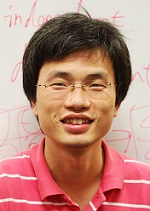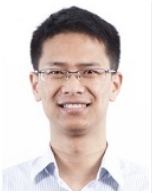CCF-CV走进高校系列报告会(第十四期,北京邮电大学)
中国计算机学会计算机视觉专委会走进高校系列报告会
CCF-CV Series Lectures
北京邮电大学·北京(第 14期)
2016年5月26日(星期四)13:30-18:00
北京邮电大学教三楼136“长年学术报告厅”
报告会主题
计算机视觉前沿技术及应用
程 序
13:00 签到
13:30 报告会开始
特邀讲者:高新波 博士,西安电子科技大学教授
演讲题目:基于物理-信息-认知空间融合的异质人脸图像合成与识别
特邀讲者:谭平 博士,360人工智能研究院 副院长
Associate professor, Simon FraserUniversity
演讲题目:3DVision – Bridging Two Worlds
特邀讲者:鲁继文 博士,清华大学副教授
演讲题目:二值特征学习在视觉分析中的应用
特邀讲者:Yi-Zhe Song Lecturer,QueenMary University of London
演讲题目:SketchAhead – going “deep” into sketches
执行主席:苏菲 博士,北京邮电大学教授,中国计算机学会计算机视觉专委会委员
参加人员:视觉领域专业人士、研究生、媒体、其他有兴趣者
报名方式:Email:pengjing94@sina.com (请于5月24日前将参会回执回复至该邮箱,邮件主题请注明“CCF-CV北京邮电大学报告会回执”)
参加方式:免费参加,敬请光临。
参会回执
姓名 | 职称/职务 | ||
电话 | |||
工作单位 | |||
注:回执仅仅针对外地和外校的人员,本校人员无需提供。
特邀讲者 高新波
高新波,男,1972年生于山东莱芜。分别于1994、1997和1999年在西安电子科技大学获得学士、硕士和博士学位。1997-1998年赴日本静冈大学学习,2000-2001年赴香港中文大学做博士后研究。现为教育部长江学者特聘教授,国家杰出青年科学基金获得者,综合业务网理论及关键技术国家重点实验室主任,科技部重点领域创新团队负责人、教育部创新团队负责人,IET Fellow、CIE Fellow、IEEE高级会员、中国计算机学会理事,中国图象图形学学会常务理事,陕西省图象图形学学会副理事长。担任Signal Processing、Neurocomputing等多个国内外学术期刊的编委,2004年入选教育部新世纪优秀人才支持计划,2006年获得霍英东教育基金会高等院校青年教师奖,2009入选新世纪百千万人才国家级人选。目前主要从事影像处理、分析和理解、模式识别和机器学习等领域的研究和教学工作,发表SCI论文160余篇,GoogleScholar引用8000余次。
报告摘要:传统的模式识别系统(如人脸识别系统)往往是构建在物理–信息空间之上的,即通过传感器获得现实世界中感兴趣目标的图像或者视频数据,然后在信息空间通过图像处理和模式识别技术进行感兴趣目标的身份认证。经典的模式识别是希望利用机器把人从繁琐劳动中解放出来,即构造一个人不在闭环中的自动化系统。然而在实践中发现,对于情况复杂的模式识别问题如果能充分利用人的经验、知识和认知结果,往往能够大大提高识别的效率和准确率,从而构建基于物理、信息和认知这三元空间融合的模式识别系统。本文以公共安全领域常用的异质人脸图像的合成与识别问题为例,介绍一种基于物理–信息–认知空间融合的模式识别新方法,并重点介绍其中核心的异质图像的变换与合成方法。
特邀讲者 谭平
Dr.Ping Tan is an associate professor at the Simon Fraser University. Before that,he was an associated professor at the National University of Singapore. Heobtained his PhD degree from the Hong Kong University of Science and Technologyin 2007. Dr. Tan’s research interests include computer vision, graphics, androbotics. He received the inaugural TR35@Singapore award, and the honorablemention award of PAMI Outstanding Young Researcher, both in 2012. Dr. Tanserves in the editorial board of the International Journal of Computer Vision(IJCV), Computer Graphics Forum (CGF), Machine Vision and Applications (MVA),and Unmanned Systems.
报告摘要:The boundary between the physical world and the cyber world starts tofade. We used to only have a glimpse of the cyber world on computer monitorsand mobile devices. Head-mounted displays and augmented reality techniquesstart to make it ubiquitous and interweaved with the real physical world. Withthese techniques, virtual objects are displayed in alignment to the realenvironment and we can interact with them just like manipulating real objects.On the other hand, a robot always walks on the edge of the physical and cyberworld. It constantly senses the real physical world to build a virtual replicafor planning and controlling its movement.
This talk presents 3D vision techniques thatfacilitate the fusion of the physical and cyber worlds, including digitizationof the real 3D world, camera motion estimation to align the two worlds, andhuman skeleton motion estimation, etc. We first introduce a novel global methodto the structure-from-motion (SFM) problem, which produces more accurateresults at the same time of significantly reduces computation cost. The 3Dpoint clouds recovered by SFM can be used to build photorealistic 3D models. Areal-time SFM system can act as a 3D sensor for robots to guide theirautonomous navigation. 3D information also makes it easy for a robot tounderstand human motion, which points to novel human-computer-interface.
特邀讲者 鲁继文
鲁继文,博士,清华大学自动化系副教授,博士生导师,中组部青年千人,IEEE高级会员。主要研究方向为计算机视觉、模式识别和机器学习,具体研究内容包括人脸识别、行人识别、图像检索、度量学习、深度学习和特征学习等。近年来在国际期刊和会议上已发表/录用学术论文130余篇(其中CCF A类期刊和会议36篇),包括IEEE汇刊论文29篇 (其中PAMI论文4篇,T-IP论文6篇),ICCV/CVPR/ECCV论文19篇。目前担任IEEE信号处理学会信息取证与安全技术委员会委员,中国计算机学会计算机视觉专委会委员,国际期刊Pattern Recognition Letters、Neurocomputing和IEEE Access的编委,PatternRecognition、Computer Vision and ImageUnderstanding和Image and Vision Computing的客座编委。
报告摘要:视觉模式的特征描述是视觉计算中的一个关键问题,特征提取的好坏直接影响着视觉分析系统的性能。报告将介绍本研究组近年来所提出一种二值特征学习方法。通过构造一个非监督特征学习模型,设计任务驱动的目标函数学习出判别能力高的二值特征。所提出的方法在包含人脸识别、年龄估计、图像匹配、物体识别和图像检索等多个视觉分析的应用中验证了其有效性。
特邀讲者 Yi-Zhe Song
Yi-ZheSong is founding Director of the SketchX Research Lab at Queen Mary Universityof London, and a Co-Director of the QMUL-BUPT joint Research Lab on ConnectedDigital Media. Since its establishment in 2011, the SketchX Lab has pioneeredand promoted research into human sketches, and had quickly developed into aworld-leading research lab on sketch analytics and its applications, with veryrecent sketch-specific publications in top conferences and journals (1 xCVPR’15, 1 x BMVC’15 Best Paper, 2 x CVPR’16). It has enjoyed many achievementsboth academically including a Best Science Paper Award at BMVC’15, andcommercially including collaborations with the Metropolitan Police on forensicsketch analysis and companies like IKEA on fine-grained sketch-based imageretrieval. Dr. Song is an Associate Editor for Neurocomputing, Area Chair ofWinter Application Conference on Computer Vision 2016, and acted as technicalcommittee members of many top conferences such as CVPR, ICCV, ECCV andSIGGRAPH, and regular reviewers for tier-1 journals such as TPAMI, TIP, IJCVand ACM ToG.
报告摘要:With theproliferation of touchscreens, sketching has become a much easier undertakingfor many – we can sketch on phones, tablets and even watches. Research onsketches has consequently flourished in recent years, both in terms of thenumber of publications (i.e., more than a dozen papers on a diverse range ofsketch-related problems in ICCV, CVPR, ECCV, BMVC, AAAI and journals such asIJCV, IEEE TIP, PR, CVIU) and their quality (e.g., Best Demo in ICCV’15 andBest Science Paper in BMVC’15).
At SketchX Lab, Queen Mary University of London, wehave been actively investigating all aspects of sketch research since 2011. Inthis talk, I will first conduct an overview of sketch research, and go on tointroduce a stream of recent work conducted in SketchX, ranging fromconventional tasks such as sketch recognition and sketch synthesis, to those wepioneered ourselves e.g., fine-grained sketch-based image retrieval andmemory-aware forensic sketch analysis. In particular, I will concentrate onsome of the deep models we proposed to solve sketch specific problems, (i) amulti-channel multi-scale model for sketch recognition (BMVC’15 Best Paper);(ii) a multi-stage triplet-ranking model for fine-grained sketch-based imageretrieval (CVPR’16 Oral). I shall also endeavor into the problem of memory-wareforensic sketch recognition and demonstrate how it is possible to reverse humanmemory via Multi-Task Gaussian Process Regression (CVPR’16 Spotlight Oral).
会场路线图
CCF-CV 网站:http://ccfcv.ccf.org.cn/
CCF-CV公众号:
推荐内容
More >>>- · 第八十三期CCF-CV走进高校系列报告会于悉尼大学圆满结束
- · 第八十四期CCF-CV走进高校系列报告会于广东石油化工学院圆满结束
- · 第七十三期CCF-CV走进高校系列报告会于苏州科技大学圆满结束
- · 第七十四期CCF-CV走进高校系列报告会于河北大学圆满结束
- · 第七十期CCF-CV走进高校系列报告会于太原理工大学圆满结束
- · 第六十八期CCF-CV走进高校系列报告会于北京信息科技大学圆满结束
- · 第三届计算机视觉及应用创新论坛在广州举办
- · 第一届中国模式识别与计算机视觉大会在广州召开
- · CCF-CV专委会2018年度全体委员会议在广州成功举办
- · 【预告】CCF-CV走进高校系列报告会(第五十八期,广西师范学院)








